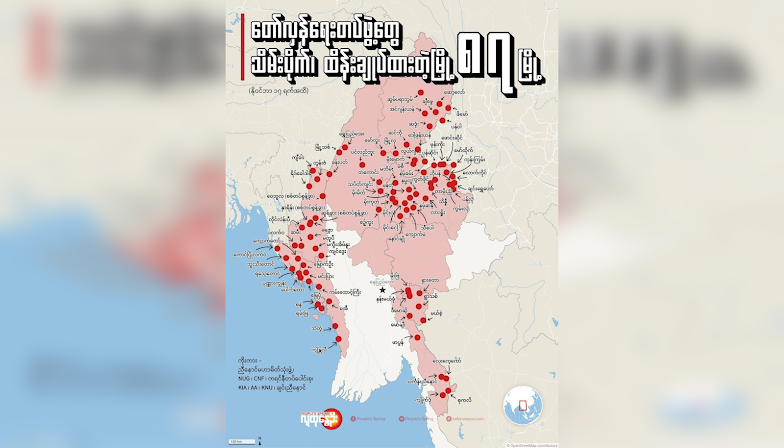Myanmar Spring Chronicle – November 17 Overview
(MoeMaKa, November 18, 2024)
Towns Captured by Resistance Forces and Regional Military Orders
Reports indicate that resistance forces have taken control of 87 towns. According to People’s Spring, the Arakan Army (AA) announced on November 14 that it had captured Kyain Thalee in Rakhine State. This was disclosed in their statement marking the first anniversary of the “Arakan and Paletwa Region Operation.” Recently, the Kachin Independence Army (KIA) captured the small border town of Hseni in Kachin State on November 2.
Additionally, the AA has reportedly launched offensives against remaining military bases and battalion headquarters in Ann, Maungdaw, Gwa, and Taungup. Local PDF forces, alongside Chin resistance groups and the CDF, are engaged in operations in Mindat and Falam towns. Despite last week’s attempt by the BNRA coalition forces to seize Palae, the operation was withdrawn.
In the south, KNU units have continued offensives against military camps and villages. Reports indicate that in the Karenni region, the military junta has reinforced its troops in preparation for counter-offensives. Reinforcements are being deployed along key routes such as the Loikaw-Mawchi-Demoso corridor and the Loikaw-Bawlakhe-Pharsong road, according to KNDF Deputy Commander Mawwi.
Security Challenges Among Resistance Forces
In addition to military developments, regional resistance groups are issuing various security directives. In central regions like Sagaing, Mandalay, and Magway, local resistance forces, PDFs under the NUG, and other armed groups are becoming increasingly active. This activity has prompted some groups to issue public warnings. For example:
- In Pauk Township, Magway, a PDF commander announced that independent armed groups entering their area without permission would face severe actions if they interfered with local governance.
- A similar announcement was made in Mying Township, where restrictions on armed movements and mine placements along roads were emphasized.
These regional dynamics underscore the growing complexity of coordination among armed groups in predominantly Bamar regions, contrasting with the more established systems of collaboration seen in ethnic territories like Chin, Karenni, and Karen areas.
Intensifying Military Tactics by the Junta
The military junta is reportedly expanding its use of aerial assets, including drones, attack helicopters, and military aircraft. Reports suggest that junta leader Min Aung Hlaing visited drone manufacturing facilities in China, citing plans to acquire drones for “agricultural and humanitarian purposes.” However, analysts speculate that these drones could be modified for combat use at the junta’s domestic weapons manufacturing facilities, such as the Ka Pa Sa factories.
Geopolitical Dimensions
The increasing involvement of China in Myanmar’s conflict raises concerns. The junta’s reliance on Chinese support, juxtaposed with China’s stance on the Spring Revolution, has become more evident. While resistance forces maintain that military strength is key to resolving the conflict, political avenues may also need to be explored to counteract the growing influence of neighboring powers like China.
In conclusion, the ongoing resistance in central Myanmar showcases a gradual shift towards broader cooperation among groups. Still, it also highlights the challenges of managing conflicts and external influences. Effective dialogue within the resistance movement and with neighboring countries will be crucial to advancing the revolution.

